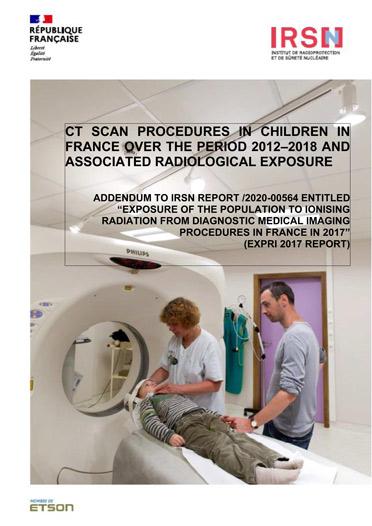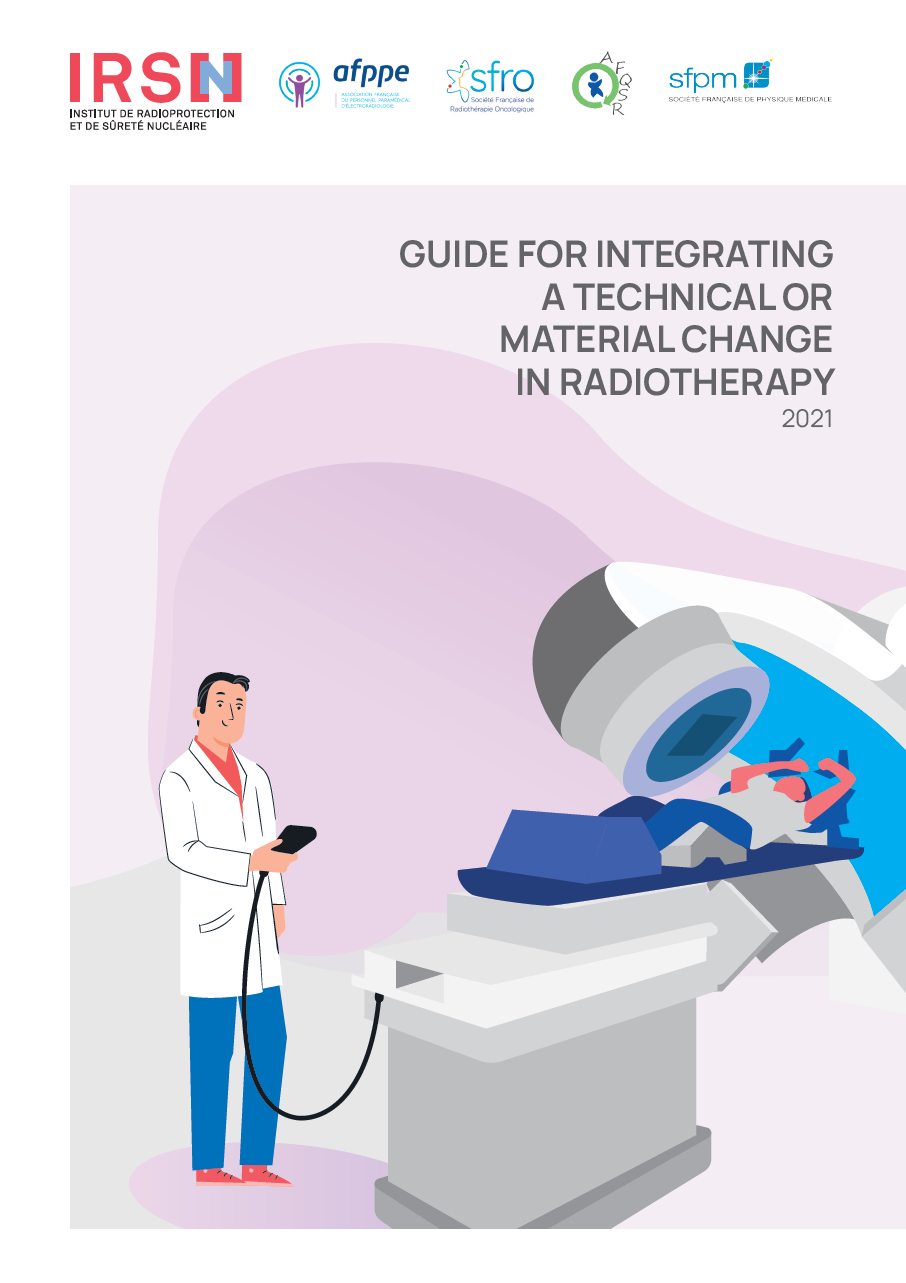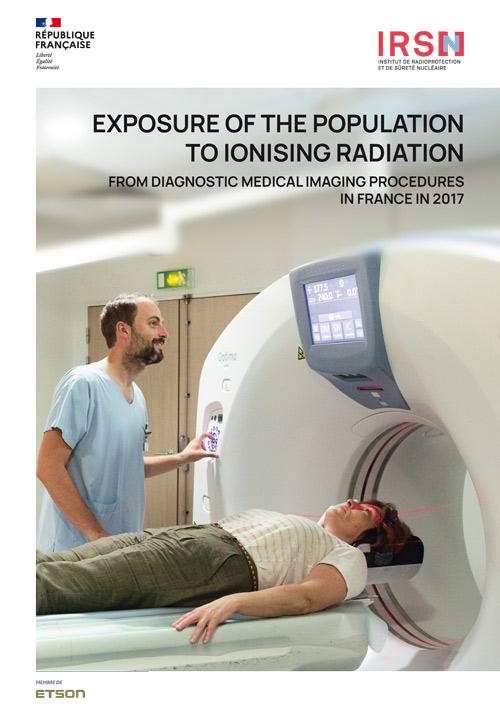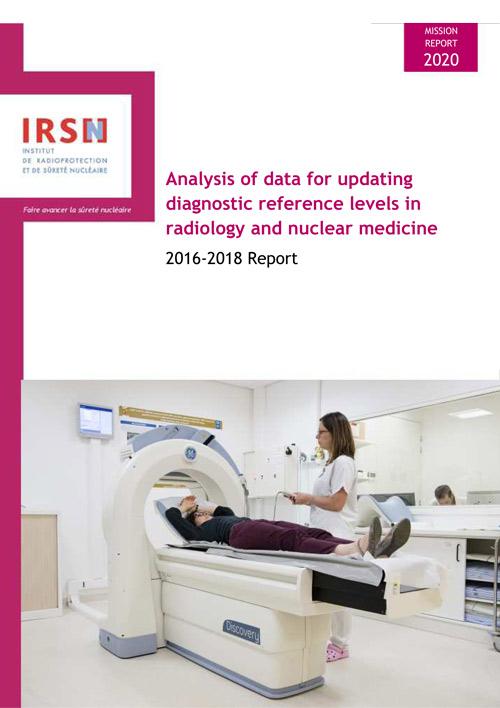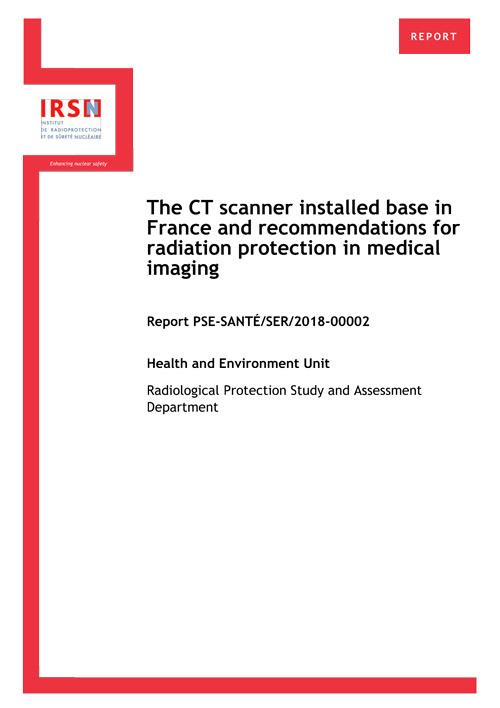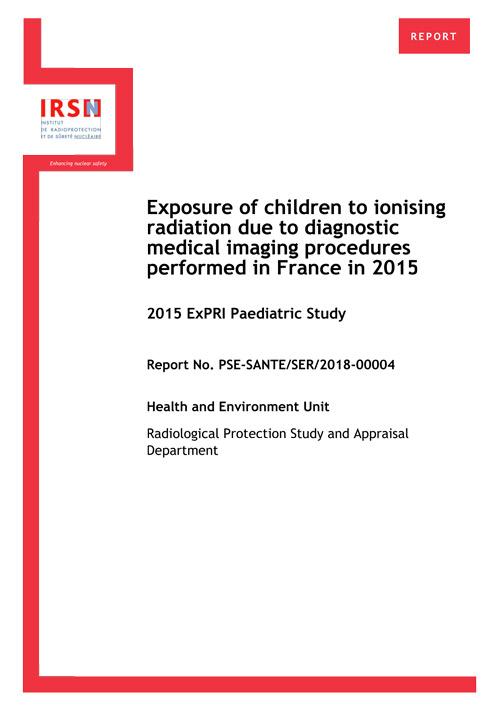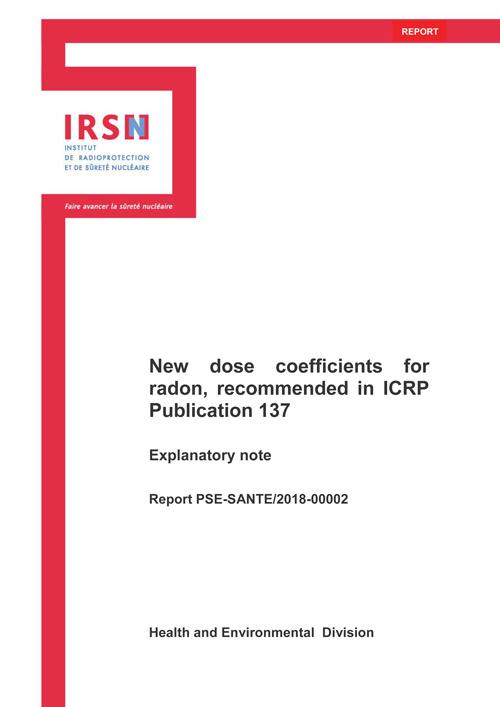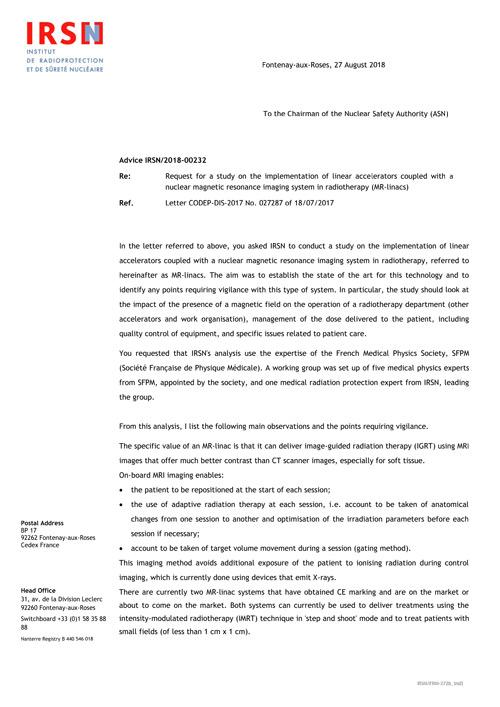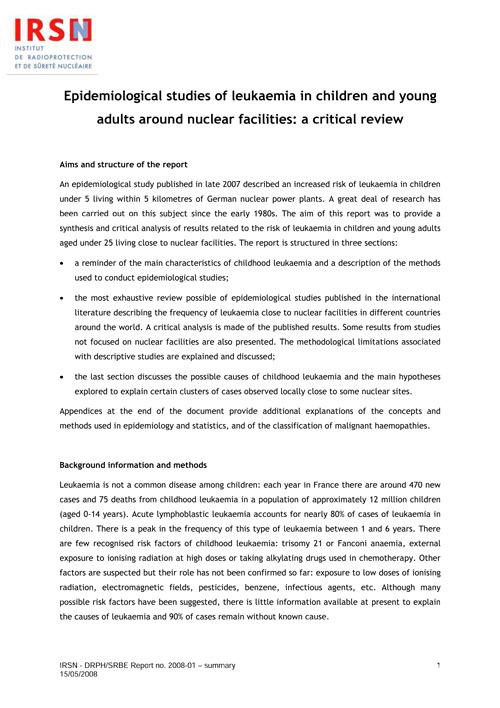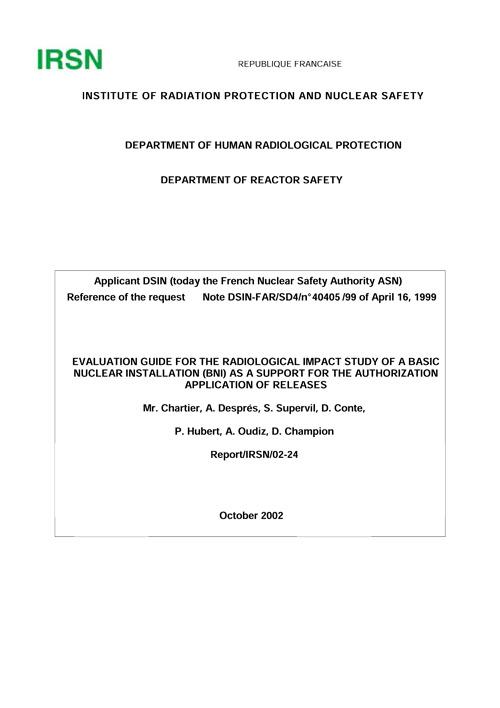Publications and reports: Health
This page contains IRSN publications and reports on radiation protection.
2023
In order to comply with the French regulations regarding the diagnostic reference levels (DRL), healthcare facilities performing medical imaging procedures are required to send samples of “patient” dosimetric data to the IRSN each year.
IRSN is responsible for analysing this data in order to update the DRL values. This report presents the results of the analysis of dosimetric data over the period 2019-2021. Results are compared to DRL values defined by the regulations in force since July 2019 to examine the need for an update.
This seventh report on the analysis of French data relating to DRLs makes it possible to take stock of the implementation of the methods introduced by ASN resolution 2019-DC-0667, in particular in paediatrics and interventional radiology.
2022
In accordance with its missions in the Code de la santé publique (French Public Health Code), the French Institute for radiation protection and nuclear safety (IRSN) periodically analyses the exposure of the French population to ionising radiation due to diagnostic medical imaging procedures. To complete the "ExPRI 2017" study on exposure to ionising radiation of the general population due to diagnostic procedures in France in 2017, a specific study was conducted about CT (computed tomography) scan procedures in children under 16 years of age in France over the period 2012-2018 and the associated radiological exposure.
This study was based on CT scan procedures in children extracted from a representative sample panel of health insurance beneficiaries. The year-by-year analysis (i.e., without individual follow-up of the children from one year to the next) made it possible to evaluate, among other things, the evolution over the period studied of:
- the frequency of CT scan procedures (number of procedures per 1,000 children) per year;
- the proportion of children who had at least one CT scan procedure per year.
Over the period 2012-2018, the annual frequency of CT scan procedures was relatively constant (across all ages and sexes) and fluctuated around 13.7 procedures per 1,000 children.
On average over the same period, the annual frequency of CT scan procedures varies greatly according to the age of the child: about 15% for children under 1 year old, less than 10% between 1 and 9 years old, then increasing to more than 35% at 15 years old.
Over the period studied, 1.1% of children under 16 years of age had at least one CT scan procedure per year. Among this population, the average number of CT scan procedures per year per child was 1.23. 11% to 16% of these children had 2 or more CT scan procedures depending on the year considered.
Since CT and MRI (magnetic resonance imaging) have a large number of common indications and the recommendations of professionals are moving towards a transfer of some procedures to MRI, a study of the evolution of MRI procedures was also carried out. This study shows that, unlike in CT, the annual frequency of MRI procedures increased significantly (+59%) over the period studied.
According to the paediatric data analysed in the Diagnostic Reference Level (DRL) system managed by IRSN, the doses received by children for a CT scan (for the brain, abdomen-pelvis and thorax) show a decreasing trend between the periods 2011-12 and 2016-18. This decrease should be interpreted with caution due to the small amount of data collected during these periods. A new order on DRLs, published in May 2019, has strengthened the provisions for sending dose assessments to IRSN in paediatrics and has made it possible to obtain more data over the period 2019-2021. Analysis of these data in the next DRL review, to be published, will provide more precise information on changes in ionising radiation doses received by children.
2021
External radiotherapy is part of a complex socio-technical system: it combines advanced technologies with human activities characterised by multiple interactions between different professions. Beyond the technical skills required, radiotherapy activities demand a high level of collaboration, or even synchronisation, among the various actors in the care process, both within the radiotherapy department and externally, such as with other departments (e.g. chemotherapy, surgery, etc.).
In this context, any material or technical change (such as installing an additional accelerator, replacing a machine, upgrading/extending the capacities of an already installed device, implementing a new technique, or deploying a new treatment planning system, or Record & Verify, etc.) represents a potential source of instability, in particular for treatment workflow and work practices by introducing complexity into the system. While some disruptions can be apprehended a priori, others are more difficult to anticipate and are discovered as the change is implemented. They may then result in the inappropriate use of the new technique or changes in the workflow that gradually weaken certain safeguards. These instabilities can ultimately cause risks for patients. Adopting a material or technical change therefore raises questions about the security of the entire care process.
Aim
This document is a guide to support radiotherapy teams in integrating material or technical changes, contributing to the delivery of safe treatments. It is intended for all actors involved in such change, both at managerial and operational levels. This French guide is independent of existing tools for project management and risk management, such as the data sheets proposed by HAS1, or the recommendations made in the context of GPMED2, and can be used in addition to those. It does not replace the regulatory requirements associated with radiotherapy. This guide has also been designed so that every radiotherapy department, regardless of size, status or organisation, can rely on the non-exhaustive recommendations provided as food for thought or action, and adapt them according to its needs and specificities, depending on the nature of the change considered.
This guide has been developed based on lessons learned from clinical professionals regarding the implementation of technical and material innovations. The recommendations and examples of questions included in this guide are intended to support centres in facilitating the integration of technical or material changes by radiotherapy professionals.
It is supplemented by lessons learned from Human and Organisational Factors (HOF) which inform the recommendations presented in this guide. An approach based on the role of HOF in risk management emphasizes consideration of the various determinants of an activity, such as organisation, management, rules, work groups, techniques, and individuals to better understand the factors that ensure safety. An HOF approach promotes a holistic understanding of the activity and enables action on these factors, either directly or through their interactions, to maintain the required level of safety.
Guide for integrating a technical or material change in radiotherapy (PDF web version)
Guide for integrating a technical or material change in radiotherapy (PDF print version)
2020
-
This report is part of the ExPRI (Exposure of the population to ionising radiation) system launched in 2003, and aims to establish data on the exposure of the French population to ionising radiation from medical imaging for diagnosis purposes (conventional, dental and interventional radiology, computed tomography and nuclear medicine) for the year 2017 and to analyse variation in such data. The study was performed based on diagnostic imaging procedures taken from the échantillon généraliste des bénéficiaires, a sample on a 1/97th scale of the healthcare consumption of the population covered by the main French health insurance schemes.
The exposure of the French population had not changed significantly in 2017 compared with 2012. Variation detected in terms of the mean frequency of imaging procedures and the average per caput annual effective dose is generally minor, excluding dental radiology. In particular, the almost 90% increase recorded between 2002 and 2012 for the average per caput annual effective dose was no longer evident between 2012 and 2017, and levels stabilised at 1.53 mSv per caput (vs. 1.56 mSv in 2012). Nuclear medicine, which ranks number 3 in terms of the collective effective dose, recorded the greatest increase over this 5-year period, in terms of both frequency and contribution to the collective effective dose. Computed tomography remains the most significant contribution to the exposure faced by the population (74.2%) by far. However, the increase in collective effective dose attributable to computed tomography (+2.4%) remains well below the frequency of these imaging procedures, which increased substantially over the period in question (+17%). The frequency of dental radiology procedures is falling steeply (-16.8%). However, this variation was driven by major changes to the CCAM (social security) codes used to record dental radiological imaging over the 2012-2017 period and cannot therefore be considered as sufficiently reliable.
In 2017, 45.4% of the population was subjected to diagnostic medical imaging procedures one or several times, representing a slight increase since 2012 (43.8%). This percentage falls to 32.7% if dental examinations are excluded. Only a small percentage of patients − but representing several hundreds of thousands of patients throughout France − combined multiple computed tomography examinations, leading to high effective doses, potentially exceeding 100 mSv. Although these patients are very certainly treated for serious pathologies, potential long-term radio-induced effects must be considered.
-
IRSN is publishing its sixth triennial report on the analysis of dosimetric data transmitted by medical imaging professionals in application of the regulations relating to diagnostic reference levels (DRL).
This report covers the data collected by IRSN over the period 2016-2018. It confirms the merits of several regulatory changes introduced by the order of May 23, 2019 in line with the strengthening of requirements at European level and the recommendations issued by IRSN in its previous reports, in particular to improve data collection and use of DRL in pediatrics.
2019
-
In answer to a joint request from the Directorate General for Health (DGS, Ministry of Health) and the Directorate for Social Security (DSS) regarding the French computed tomography (CT) scanner installed base and recommendations on good practices taking into account the needs of radiation protection in medical imaging, IRSN used two databases for which it is responsible by regulations: SIGIS, the information and radioactive sources management system, and the application for the diagnostic reference levels management. IRSN also held hearings with associations of professionals on topics in connection with the request.
This study highlights the need for change by focusing on IRSN’s field of competence: radiation protection.
-
The purpose of this report is to establish data for the year 2015 on the exposure of French children aged under 16 years to diagnostic medical imaging procedures involving ionising radiation (conventional and dental radiology, diagnostic interventional radiology, computed tomography and nuclear medicine). The study was conducted using the échantillon généraliste des bénéficiaires, a sample on a 1/97th scale of the healthcare consumption of the population covered by the main French health insurance schemes.
Around 604 diagnostic procedures per 1.000 children were performed in 2015, a near stable figure (+1.5%) compared to the year 2010. The proportion of children who had at least one diagnostic procedure was 31%, up by 2 points from 2010. The annual mean effective dose is 0.135 mSv per child, exposed or not, down 25% from 2010, while the mean effective dose per exposed child is 0.43 mSv, down 34% from 2010. Exposure is extremely varied among exposed children, since half of them received a cumulative annual effective dose of 0.02 mSv or less. Relative to the number of children exposed in their age group, children aged under 1 year are the most highly exposed category, with a median annual effective dose of 0.55 mSv.
Children's exposure to ionising radiation originating from diagnostic medical imaging procedures decreased markedly in France between 2010 and 2015, even though the mean frequency of these procedures remained nearly stable over the same time period. This reduction in exposure is therefore due solely to an overall decrease in the mean dose per medical imaging procedure, which is related to improvements in technologies and practices.
2018
-
In January 2018, the International Commission on Radiological Protection (ICRP) issued its Publication 137 (Occupational Intakes of Radionuclides: Part 3). That document is part of a series of publications that aim to provide basic data and parameters, for the main chemical elements and their radioactive isotopes, to describe the distribution of these elements in the human body in the event of intake.
IRSN’s explanatory note presents the new dose coefficients adopted by the ICRP for radon inhalation, specifies the assumptions and scientific data on which they are based, and discuss the associated uncertainties.
In 1993, the dose coefficients for exposure to radon and its progeny recommended in ICRP Publication 65 were 1.4 mSv per mJ h m-3 for workers and 1.1 mSv per mJ h m-3 for the public respectively. These coefficients were based on an epidemiological approach.
Taking the dosimetric approach into account, the ICRP recommends in its Publication 137 using a dose coefficient of 3 mSv per mJ h m-3 for workers in underground mines and in buildings in most situations. This dose coefficient also applies to public exposure situations in dwellings. For specific indoor work situations involving intense physical activity and for tourist caves, it recommends a dose coefficient of 6 mSv per mJ h m-3.
-
In the frame of the marketing of new radiation therapy devices coupling a linear electron accelerator to a magnetic resonance imaging system (MR-linac), the French Nuclear Safety Authority requested IRSN to provide a state of the art for this technology and to identify any points requiring vigilance.
IRSN's analysis relied on the expertise of the French Medical Physics Society, SFPM. The numerous observations and recommendations established by the IRSN/SFPM working group are synthesized in the advice published by the IRSN.
2008
The German Federal Institute for Protection against Ionising Radiation made public a multi-site epidemiological study on 10 December 2007. This study covered 16 nuclear sites in Germany. The study meets the international scientific criteria.It establishes an excessive risk of leukaemia in children under five living within a radius of 5 km around German nuclear power plants.
The IRSN epidemiologist researchers have undertaken a critical review of all international scientific literature on the risk of leukaemia in children living near nuclear facilities.
2002
At the time of a licence application of effluent releases and water pumping of basic nuclear facilities (BNF), the operator of the installation must in particular provide a radiological impact study of the radioactive effluent releases coming from the installation on the environment and on pubic health.
An impact study of the radioactive releases represents technical and conditional specifications. It was for this reason that the French Safety Authority (ASN then DSIN) and the Directorate-General of Health Services (DGS) requested IRSN (then IPSN), in April 1999, to develop a guide facilitating the review of such a study, as well for the services implied in the examination of the licence applications, as for all the concerned parties in this field.
The objective of the guide is to take into account the regulatory context which underlies the development of the impact studies (decree n°95-540 of May 4, 1995, modified by the decree n°2002-460 of April 4, 2002, and the Euratom guidline 96/29 of May 13, 1996, known as “the basic standard guideline”, accompanied by its transposition texts in French law).
In this precise context, the guide proposes to assess the radiological impact study of a BNF from three different angles:
- the description and the quantification of the produced effluents, by taking account of the triggering processes, of the different processing measures and of the procedures to optimise the reduction of the produced effluents;
- the estimate of the dosimetric impact of the planned releases on the population, taking into account the environmental characteristics of the installation;
- the definition of the conditions to monitor the releases and the environment.
This guide provides a general condition logical framework adaptable to any particular situation met.

